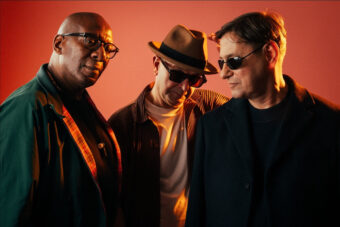By: Matthew WebberBoth the upcoming Ewan MacGregor drama, Young Adam, and theDavid Byrne-penned soundtrack, Lead Us Not Into Temptation,use water as a central theme. Sure, people die and strings getplucked, but the chorus of Byrne’s Talking Heads classic,“Once In a Lifetime,” works equally well as plotsummary and movie review:
“Letting the days go by / let the water hold me down / Letting the days go by / water flowing underground / Into the blue again / in the silent water / Under the rocks and stones / there is water underground.”
McGregor’s character (a young Scottish drifter and barge worker named Joe) and Byrne don’t so much as act as they are acted upon, watching or listening to water ebbing and flowing. As the opening credits flicker on the screen, Joe and a barge family discover the body of a young woman in the river. Byrne’s accompanying dirge, “Body in a River,” is almost indistinguishable from the gentle, lapping waves. Cymbals crash like waves and strings sound like gulls; the movie and the music are equally languid, refractions and reflections gently distorting the fabric of reality. The movie, based on the novel by Scottish beat writer Alexander Trocchi, explores the existential themes of guilt and alienation, asking more questions than it attempts to answer.

Also Read
Compact Discs: Sound of the Future
But as the movie’s main character, Joe doesn’t quite cut it-he mostly just floats along, both literally and figuratively, for uninterrupted minutes. He’s into having sex, but that doesn’t make for much of a plot either: Although Joe’s boss (played by Tilda Swinson) leaves her son’s father for Joe, Joe seems to enjoy smoking cigarettes and staring at the water more than he does rocking the boat. (We learn via a flashback sequence that the dead girl is Joe’s ex-girlfriend, with whom he used to smoke and, yes, have sex with–in one memorable scene, Joe drenches her in condiments as the sound of manic jazz unspools in the background.)
Byrne composed his score through a unique collaboration with the director, David Mackenzie, and various Scottish musicians–including members of Mogwai, Belle and Sebastian, and the folksy Appendix Out–sometimes writing notes and transcriptions in New York and sending them to the musicians, other times allowing them to improvise. As Byrne himself writes in the promo copy, “At its best, [the music] almost invisibly blends with the background sounds of the film–the sounds of the barge, the docks, the plates, the sex, the dishes?maybe at its best it’s not even noticeable as ‘music’ but as an extension, a music interpretation of ambient sounds.”
The music is almost as existential as the film–it’s certainly tense, and it fairly drips with dread. It crescendos from murmur to roar. Soundtracks, of course, are meant to be background music, but Lead Us Not Into Temptation is not so much music as a series of sound effects, the subtle, aural ripples in Young Adam‘s mise-en-scène. Without the accompanying film to anchor it, however, it tends to drift. The movie, too, is somewhat slow; its overall angst somewhat stifling. Without Byrne’s work to buoy it, it’s tiredly treading water.



